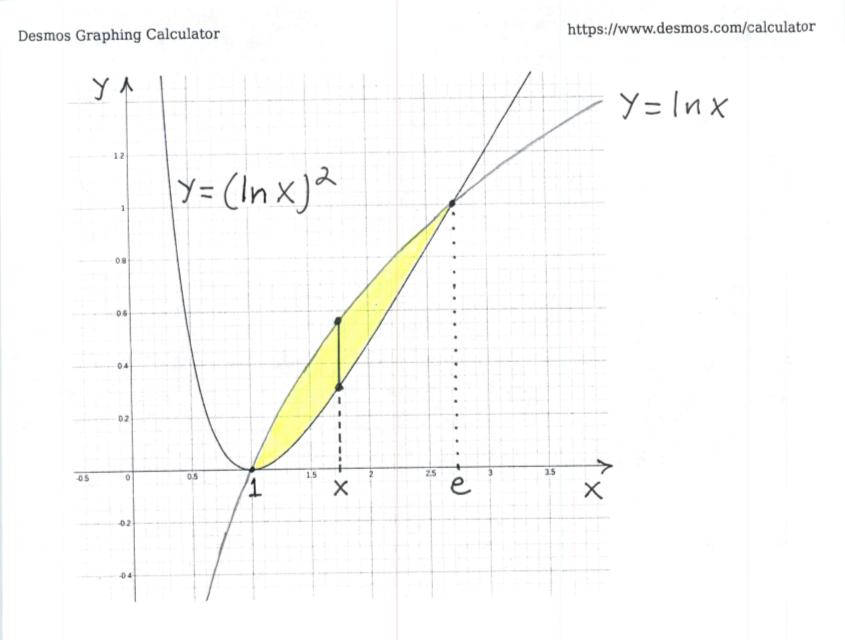SOLUTION 9: Compute the area of the
region enclosed by the graphs of the equations $ y=\ln x $ and $ y=
(\ln x)^2 $ . Begin by finding the points of intersection of the
two graphs. From $ y=\ln x $ and $ y= (\ln x)^2 $ we get that
$$ \ln x = (\ln x)^{2} \ \ \longrightarrow $$
$$ \ln x - (\ln x)^{2} = 0 \ \ \longrightarrow $$
$$ \ln x (1 - \ln x) = 0 \ \ \longrightarrow $$
$$ \ln x = 0 \ \ or \ \ \ln x = 1 $ $ \ \ \longrightarrow
\ \ x = 1 \ \ or \ \ x = e $$
$$ \displaystyle 2x = 2 \ \ \longrightarrow \ \ x = 1 $$
Now see the given graph of the enclosed region.

Using vertical cross-sections to describe this region, we get that
$$ 1 \le x \le e \ \ and \ \ (\ln x)^{2} \le y \le \ln x , $$
so that the area of this region is
$$ AREA = \displaystyle{ \int_{1}^{e} (Top \ - \ Bottom) \ dx } $$
$$ = \displaystyle { \int_{1}^{e} (\ln x - (\ln x)^{2}) \ dx } $$
$$ = \displaystyle{ \int_{1}^{e} \ln x \ dx} - \displaystyle{ \int_{1}^{e} (\ln x)^{2} \ dx } $$
$\Big($ Use Integration by Parts for $ \ \displaystyle \int (\ln x)^{2} \ dx $ . Recall that the Integration by Parts Formula is
$ \ \int u \ dv = uv - \int v \ du $. Let $ \ u = (\ln x)^{2} \ $ and $ \ dv = dx \ $, so that $ \ du = 2 \ln x \cdot \displaystyle \frac{1}{x} \ dx \ $ and $ \ v = x $. Then
$$ \displaystyle \int (\ln x)^{2} \ dx = x (\ln x)^{2} - \displaystyle \int 2 x \ln x \cdot \frac{1}{x} \ dx
= x (\ln x)^{2} - 2 \displaystyle \int \ln x \ dx $$
Use Integration by Parts again. Let $ \ u = \ln x \ $ and $ \ dv = dx \ $, so that $ \ du = \displaystyle \frac{1}{x} \ dx \ $ and $ \ v = x $. Then
$$ x (\ln x)^{2} - 2 \displaystyle \int \ln x \ dx
= x (\ln x)^{2} - 2 \Big[ x \ln x - \int x \cdot \frac{1}{x} \ dx \Big]
= x (\ln x)^{2} - 2 \Big[ x \ln x - \int 1 \ dx \Big]
= x (\ln x)^{2} - 2 (x \ln x - x ) + C
= x (\ln x)^{2} - 2 x \ln x + 2x + C \ \Big) $$
Continuing with the definite integral, we get that
$$ \displaystyle{ \int_{1}^{e} \ln x \ dx} - \displaystyle{ \int_{1}^{e} (\ln x)^{2} \ dx }
= \displaystyle{ \Big( \Big(x \ln x - x \Big) - \Big( x (\ln x)^{2} - 2 x \ln x + 2x \Big) \Big) \Big\vert_{1}^{e} } $$
$$ = \displaystyle{ \Big( - x (\ln x)^{2} + 3 x \ln x - 3x ) \Big) \Big\vert_{1}^{e} } $$
$$ = \displaystyle{ \Big( - e (\ln e)^{2} + 3 e \ln e - 3e \Big) - \Big( - (\ln 1)^{2} + 3 \ln 1 - 3 \Big) } $$
$$ = \displaystyle{ \Big( - e (1)^{2} + 3 e (1) - 3e \Big) - \Big( - (0)^{2} + 3(0) - 3 \Big) } $$
$$ = \displaystyle{ ( - e ) - ( - 3 ) } $$
$$ = \displaystyle{ 3-e } $$
Click HERE to return to the list of problems.

